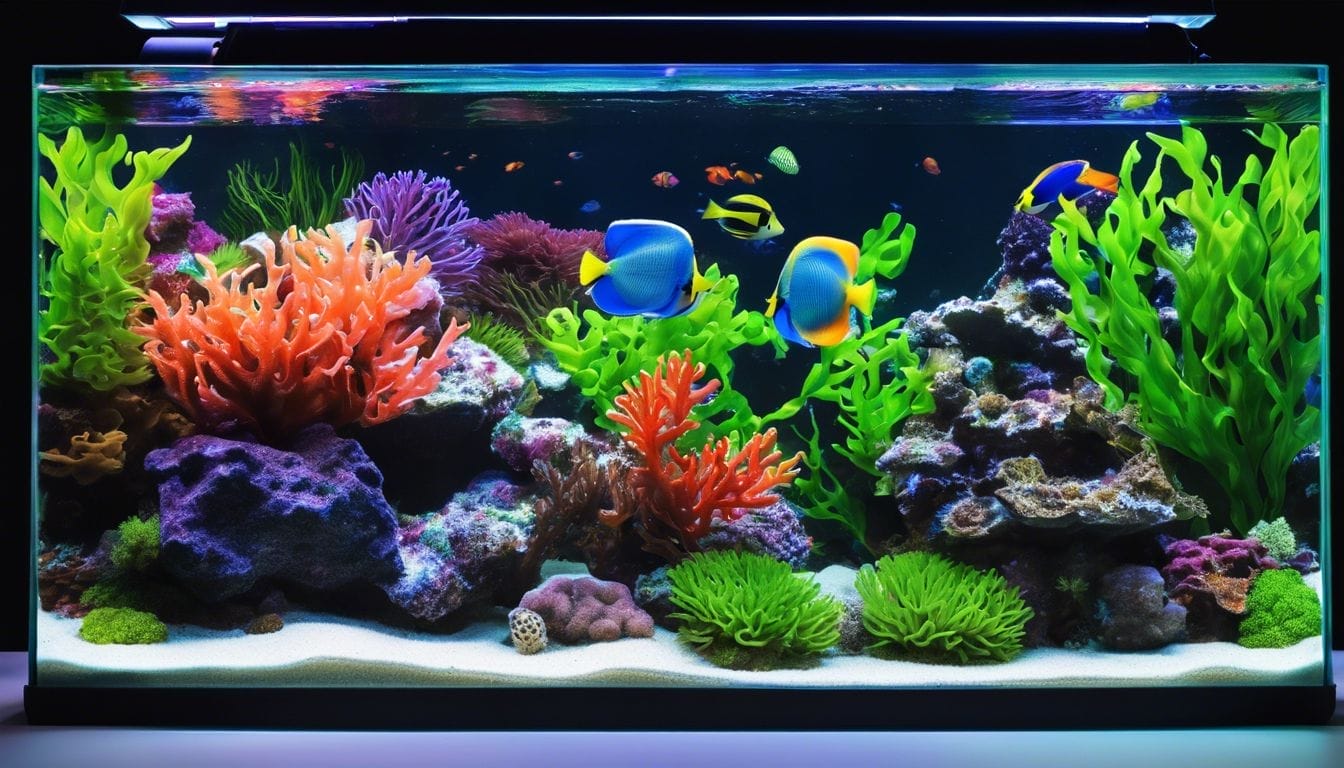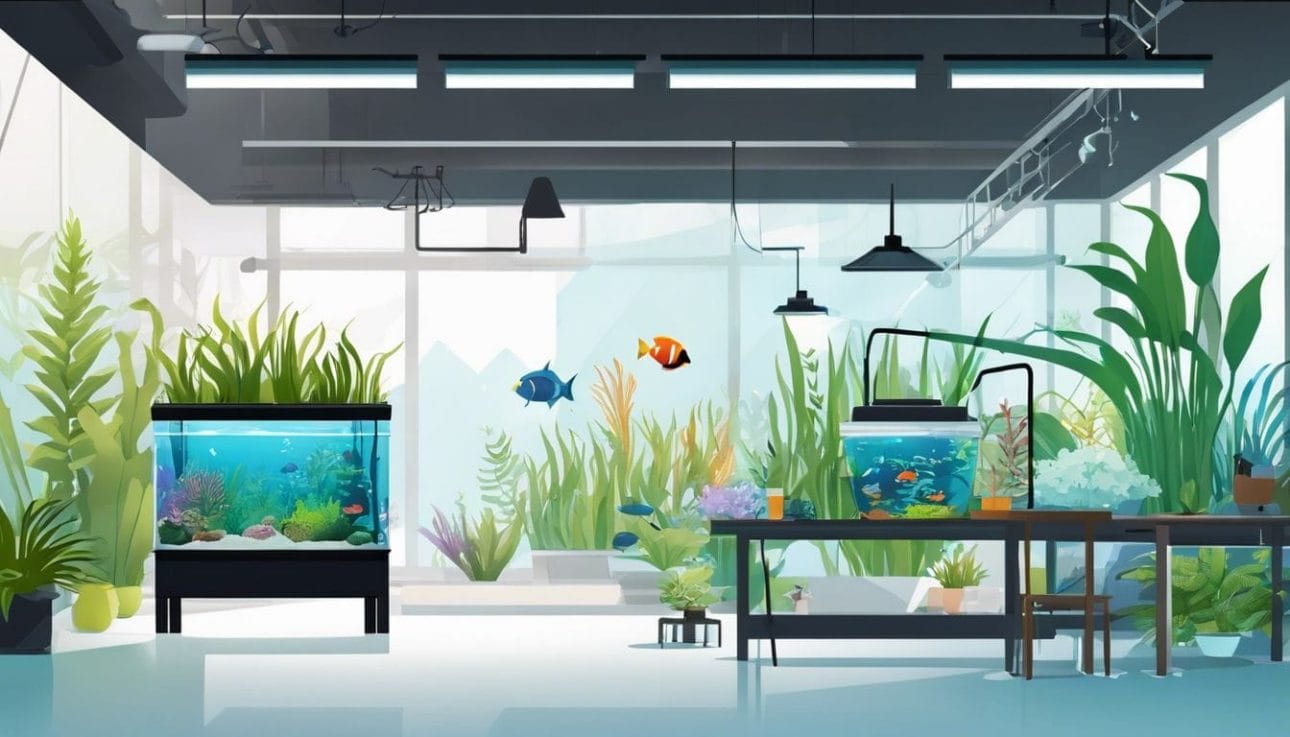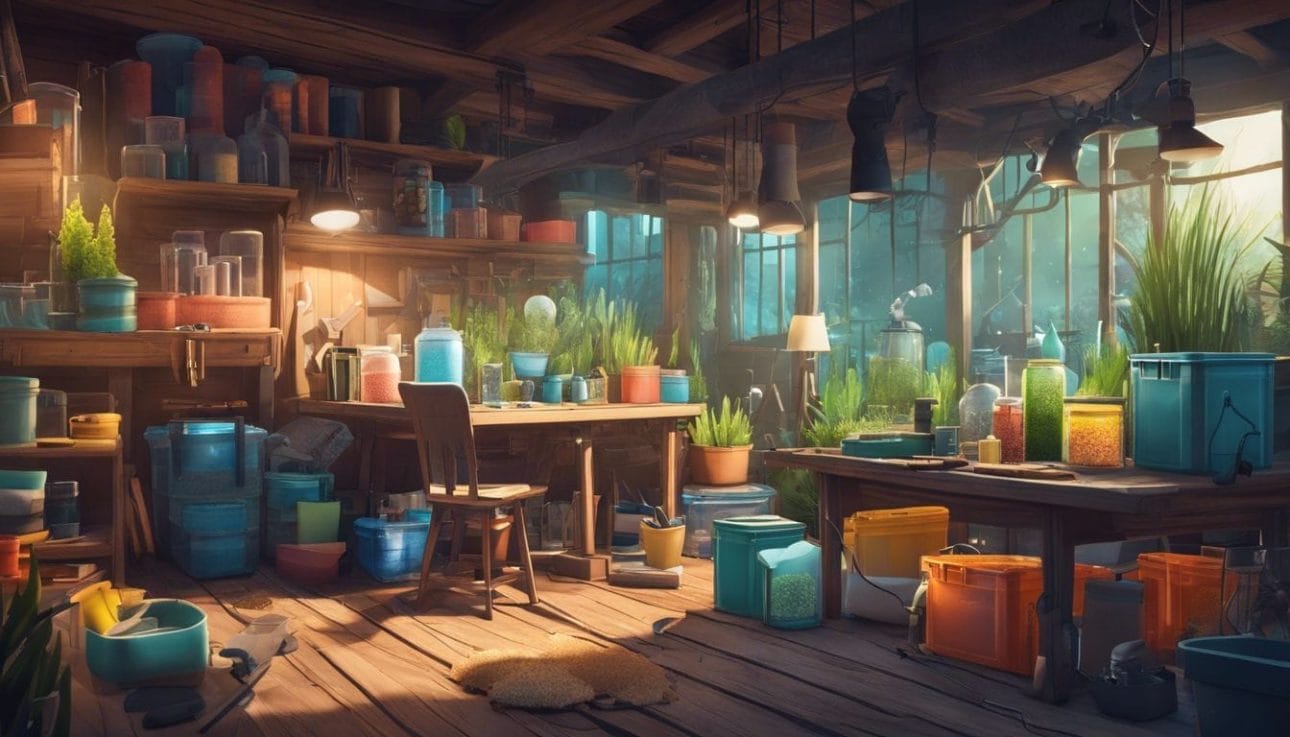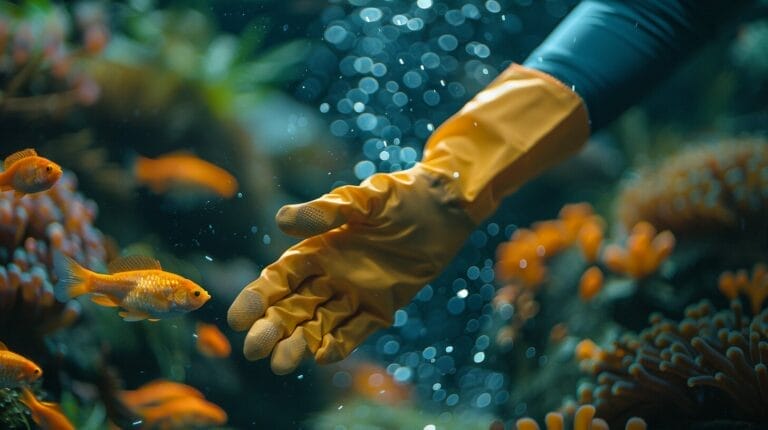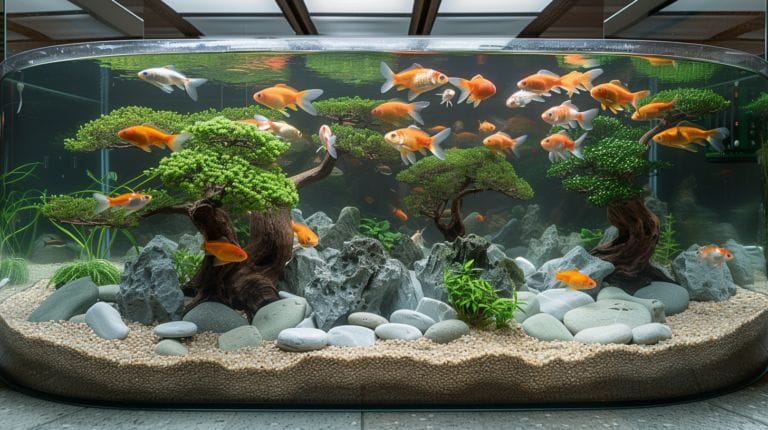DIY Fish Tank Filters: 3 Creative Ways to Make Your Own Aquarium Filter at Home
Aquarium enthusiasts know the vital role filters play in maintaining a thriving underwater community, yet many overlook the potential of crafting their own filtration system. With years of hands-on experience navigating the vast waters of aquarium care, I’ve harnessed practical insights that shatter the myth: sophisticated filters need not come with a hefty price tag or brand name.
Home-made marvels can be just as efficient and rewarding for small tanks and marine aquariums alike.
Indeed, one standout fact from my aquatic adventures is this—you don’t need to break the bank for pristine water conditions. By leveraging simple items like sponges, plastic bottles, and plumbing fittings found in your local hardware store, you can concoct a cost-effective solution tailored perfectly to your fishy friends’ habitat.
Gear up; it’s time to dive into DIY mastery!
Key Takeaways
- You can make your own fish tank filters using simple materials like sponges, plastic bottles, and containers.
- DIY filters save money and can be tailored to fit the specific needs of your aquarium.
- It’s important to clean and maintain homemade filters regularly for the health of your fish.
- When making a filter at home, use only safe materials and follow safety guidelines with tools.
- Check homemade filters often to ensure they are working properly and not damaged.
The Importance of Aquarium Filters
Fish need clean water to stay healthy, just like we need fresh air to breathe. Aquarium filters play a big role in making this happen. They take out the bad stuff from the water, such as waste, food bits that didn’t get eaten, and harmful chemicals.
Without a filter, fish could get sick or even die because their home would not be safe.
Making your own DIY aquarium filters can save you money and let you customize them for your specific fish tank needs. Whether you have a small bowl or a big tank, homemade filters can do an awesome job keeping the water clean for your underwater friends.
Plus, it’s fun to build something with your own hands that helps take care of your fish!
Setting Up Your Fish Tank Filter: An Overview
Setting up your fish tank filter is more than just a task; it’s creating the heart of your aquarium’s ecosystem. A filter mimics the natural currents and cleanliness of wild habitats, ensuring that the water stays clear, oxygenated and free from harmful waste products.
It’s not merely about maintaining aesthetics but providing essential functions to support life within your aquatic space — circulation keeps conditions stable while fostering beneficial bacteria growth.
Your DIY filtration journey begins with understanding that every thriving tank operates on the principles of mechanical, biological, and chemical balance. Mechanical filtration removes visible debris; biological processes break down waste invisibly at a microbial level; chemical media purify by absorbing toxins like ammonia or nitrates.
From sponge filters for simple setups to more complex under-gravel systems meant for larger bodies of water, choices abound. The key is finding what works best for you and your finned friends’ specific needs—and sometimes, what you need can be handcrafted right at home.
Diving into DIY realms opens up endless possibilities where creativity meets functionality—think everyday items transforming into lifesaving equipment. With basic supplies such as sponges, pipes or repurposed plastic containers along with pumps and garden hose segments – all readily available – you’re set to embark on crafting bespoke solutions designed specifically for your aquatic environment.
Let’s roll up those sleeves because next up we’ll explore three creative types of DIY fish tank filters sure to keep those waters pristine!
Three Creative DIY Fish Tank Filters
Dive into the world of customization and innovation with these three unique DIY fish tank filters that not only save you money but also allow you to tailor your filtration system to meet the specific needs of your aquatic haven—get ready for clear waters ahead!
Sponge Filter
Sponge filters are a hit for anyone who loves fish and clear tank water. They’re cheap and work great to clean your aquarium. Think of them like a vacuum cleaner for your fish’s home, sucking up dirt and keeping the water nice and tidy.
You’ll find sponge filters in many places where people breed fish or sell them. Why? Because they get the job done without costing you an arm and a leg. Plus, setting one up is super easy – even if you’ve never tried making anything like it before!
Capsule Filter
A capsule filter is a nifty little gadget for your small fish tank. It’s made from everyday items like film canisters or empty fish food containers. These tiny filters are perfect for tight spaces and work great in smaller aquarium setups.
You’ll love how they help good bacteria grow in your tank’s water, making it healthier for your fish.
You make one by putting holes in the container, adding filter media inside, and attaching an air line to pull water through. This simple setup means that even if you’re new to keeping fish, you can create an effective filtration system without much fuss or expense.
Capsule filters offer a smart way to ensure clean water for your aquatic buddies without taking up too much space or needing complicated tools.
Bottle Filter
Making your own bottle filter is a smart move for small tanks. It’s quite simple and uses things like old film canisters or fish food containers. This type of filter is really popular because you can find the materials easily and tweak them until they work just right in your tank.
Start by grabbing an empty container, some filter media, and tubing. You’ll put together a handy filter that boosts good bacteria and keeps the water clear. Some folks might think bottle filters are too weak, but with a bit of adjusting, they do an amazing job in small aquariums! They give under-gravel filters a run for their money without taking up much space.
How to Make Your Own Sponge Filter
Dive right into crafting an efficient sponge filter that’s not only budget-friendly but remarkably simple to construct. You’ll transform a few basic supplies into a reliable aquarium ally, ensuring your aquatic friends thrive in crystal-clear waters.
Gather the necessary materials
Making your own sponge filter is simple and fun. You’ll need a few things to get started, and here’s what to gather:
- A clean sponge: Choose one that’s big enough for your fish tank but can easily fit without cramming.
- An air pump: This will help move the water through the sponge and keep it clean.
- Some airline tubing: This connects the air pump to the rest of the filter.
- An airstone: It helps make small bubbles for better water movement.
- A check valve: This keeps water from going back into the air pump if it’s turned off.
- Plastic tubing or a small PVC pipe: This will hold the airstone in place inside the sponge.
- Zip ties or suction cups: You’ll use these to keep your filter in one spot in your tank.
Follow the steps to assemble
Making your own sponge filter is a smart way to keep your aquarium clean. Here’s how you can put one together with a few simple steps.
- Get a sponge that fits your tank size.
- Find a small plastic tube to be the air passage.
- Cut a hole in the sponge for the tube, but make sure it’s snug.
- Attach an air pump to the top of the plastic tube.
- Use airline tubing to connect the air pump and tube.
- Place the sponge filter gently into your tank, with the tube sticking up.
- Turn on the air pump and check for bubbles coming out of the sponge.
How to Make Your Own Capsule Filter
Crafting a capsule filter for your aquarium is like building a tiny underwater fortress for beneficial bacteria. With just a few items, you can create an efficient filtration system that keeps water crystal clear – let’s dive into the assembly process and make something amazing for your fish friends!
List of items needed
Making your own fish tank filter is a fun project. You can create something helpful for your aquarium with just a few items.
- A clean, empty film canister or a prescription container: Make sure it has a tight-fitting lid to ensure water doesn’t leak out.
- Small drill or nail and hammer: You will use this to make holes in the canister.
- Airline tubing: This tube connects the filter to an air pump which helps move water through the filter.
- Aquarium safe silicone sealant: Use this to seal any gaps and keep everything watertight.
- Ceramic rings or small bio-balls: These are the media that will host beneficial bacteria and help clean the water.
- Air pump: It provides the power needed to pull water into the filter and push it back out into your tank.
- Check valve: This little device stops water from going back into the air pump if there is a power cut.
Step by step guide
Having a clean fish tank is key for your fish to stay happy and healthy. You can make your own filter at home with a few simple items.
- Gather a clean sponge, air tubing, an air pump, and some suction cups.
- Cut the bottom of the sponge to make it flat. This helps it stand in the tank.
- Create a small hole in the top of the sponge.
- Take one end of the air tubing and push it into the hole you just made.
- Connect this tubing to your air pump outside of the tank.
- Use suction cups to hold the sponge at your desired spot inside the tank.
- Turn on the air pump and watch your homemade filter work!
- Find a small capsule like an empty fish food container or an old pill bottle.
- Make sure it’s clean and safe for your fish.
- Drill or poke holes in one end of the capsule; this is where water will flow out.
- Fill it with filter media like cotton pads or ceramic rings.
- Close up the capsule with its lid so that everything stays inside.
- Attach air tubing from an air pump to push water through your new filter.
- Grab an empty plastic bottle and clean it well.
- Cut off its bottom and drill/poke holes in its cap — that’s for water flow too!
- Slip on some pantyhose over the open bottom; this catches big waste pieces.
- Fill your bottle with more filtering stuff—sponge pieces are great here!
- Upend it into your tank, with water going inside through pantyhose – covered end.
How to Make Your Own Bottle Filter
7. How to Make Your Own Bottle Filter:.
Transform that empty plastic bottle into a lifeline for your finned friends; we’re diving into the nifty process of crafting an eco-friendly, cost-effective filter—step by exhilarating step.
Ready your DIY spirit and let’s channel those creative currents to ensure crystal-clear waters in your aquarium haven!
Materials required
Turning your home into a place for creative projects can be exciting, especially when you’re making a filter for your fish tank. A DIY aquarium filter not only saves money but also allows you to understand how your fish’s environment stays clean.
- A large sponge: Pick one that’s safe for aquariums, this will trap the debris.
- Air tubing: This tube connects your sponge to an air pump.
- An air pump: It moves air through the tubing and helps water flow through the sponge.
- A check valve: This little part keeps water from going back into the air pump if it stops.
- Some small weights or suction cups: These hold your sponge at the bottom of the tank.
- Small containers like film canisters or empty fish food jars: They become the body of your filter.
- Filter media like foam block or floss: Place this inside your container to catch dirt in the water.
- A drill with a small bit: Make tiny holes in the containers for water flow.
- Plastic tubing: This directs clean water back into your tank.
- An empty plastic bottle: This becomes the shell of your filter. Make sure it’s clean!
- Scissors or a knife: Cut out parts to shape your bottle filter.
- Foam or filter pad pieces: These act as stages that catch different types of dirt in water.
- Gravel or ceramic rings (optional): If you add these inside, they help good bacteria grow.
Instructions for assembly
Making your own aquarium filter can be fun and easy. Let’s dive into how to assemble a bottle filter for your fish tank.
- Start by finding a clean, empty water bottle. Make sure it’s rinsed well and free of any old drink or juice.
- Grab some scissors and carefully cut off the bottom of the bottle. This will become the top part where water flows out.
- Take activated carbon, which you’ve already rinsed under running water, and get ready to use it.
- Put a layer of filter floss or sponge at the bottom—or now the top—of your upside-down bottle.
- Next, place the activated carbon on top of the filter floss. This helps remove toxins from the water.
- Add another layer of filter floss on top of the carbon to keep everything in place.
- Drill or poke small holes in the cap of the bottle; this is where clean water will come out. Then screw it back onto what used to be the top of the bottle.
- Now, submerge this new DIY filter into your fish tank with the cap side facing up.
- Use an air pump and attach an airline hose to push water through your homemade filter.
Tips for Maintaining Your DIY Fish Tank Filters
Ensuring your DIY aquarium filters remain effective is crucial — think of it as routine health checks for an aquatic ecosystem. Regular tune-ups and a watchful eye can keep the waters crystal clear, ensuring your finned friends thrive in a pristine environment.
Regular cleaning
Keep your DIY fish tank filters in tip-top shape with some regular cleaning. Just like a neat and tidy house is good for you, clean filters are great for your fish. Be gentle though! Too much scrubbing can wash away the good bacteria that help keep the water safe.
You’ll know it’s time to clean when water starts moving slow through the filter.
Make sure to check your filters often for any signs of dirt building up. A quick rinse or a light brush off might be all they need to work well again. But remember, only clean them when they really need it—this way, those helpful bacteria stay put! Clean water equals happy fish; it’s as simple as that.
Ensuring proper flow rate
You want the water in your fish tank to move just right. If it’s too strong, your fish get stressed; if it’s too slow, the tank won’t clean well. Find that sweet spot where the water moves enough to filter out the dirt but still lets your fish swim comfortably.
To do this, watch how fast things float around in your aquarium when you turn on your DIY filter. Adjusting might mean changing the size of some parts or moving things around until it feels perfect for your finned friends.
Make sure you check on how hard your filter works from time to time. Use a flow meter if you have one to be extra sure about the speed. Your homemade filters are like heartbeats for your aquarium – they keep everything going smoothly as long as they’re ticking at the right pace!
Checking for damage
Look at your DIY fish tank filter often to find any breaks or blocks. Broken parts can make the water dirty and hurt your fish friends. Check out the stuff that cleans the water, tubes, and pumps to see if they’re worn or stuck with things.
Even small damage can cause big problems over time.
Be smart about how you keep an eye on your filter. Catching issues early means fixing them is easier and keeps your tank safe for your underwater pals. If something seems wrong, don’t wait – fix it! Now let’s talk about what you should watch out for when making a DIY aquarium filter to keep everyone safe.
Warnings and Precautions when Making DIY Fish Tank Filters
Venturing into the world of DIY fish tank filters can be an exciting endeavor, but it’s crucial to tread carefully. Here, you’ll discover how to navigate the potential pitfalls, ensuring your aquatic creations thrive without exposing them—or yourself—to unnecessary risks.
Safety while handling tools
Be careful with your tools! You need to keep safe while making a fish tank filter. Always wear gloves and eye protection like goggles. This keeps you from getting hurt by sharp or dangerous things.
Keep kids and pets away from your work area, so they stay safe too. And watch out for electric stuff if you’re using power tools – make sure everything is dry and you don’t get shocked.
Follow what the tool’s instructions say, so you don’t have any accidents while building your awesome aquarium filter!
Ensuring no harmful materials are used
Make sure you only use safe stuff for your fish tank filter. Some things can hurt your fish or plants. Look up if the materials are okay for aquariums. This keeps bad chemicals out of the water.
Choose items that won’t poison your tank. Check every piece before you use it. Use plastics and sponges that are safe for fish. This helps your fish live in a clean and healthy home.
Conclusion
Alright! You’ve got the scoop on making your own fish tank filters. These DIY ideas are not only easy but also let you tailor things just for your aquarium. Sponge filter, capsule filter, or bottle filter – they’re all great choices that keep the water clean and save you money too.
Remember to check your handmade filters often to make sure they work right. Don’t forget, safety comes first when you put together these projects at home. Dive in and enjoy creating a healthy home for your fish with a personal touch!
If you’re looking for more detailed instructions on setting up your fish tank filter, check out our comprehensive guide here.
FAQs
1. Can I really make my own fish tank filter at home?
Yes, you sure can! You don’t need special skills or tools. With a few items, you can put together a homemade filter that keeps your aquarium water clean.
2. What do I need to create a DIY aquarium filter?
To start making your own filter, gather some basic things like a plastic bottle, sponge, and maybe even an air pump if you want to get fancy. These simple parts work together to give you a clear tank.
3. How does my homemade filter help my fish stay healthy?
A good DIY filter pulls out the bad stuff from the water—like leftover food and fish waste—that can make your finned friends sick. It keeps water moving too, just like in nature!
4. Are there different kinds of filters I can build myself?
For sure! There’s not just one way—there are many creative ways to craft your very own aquarium filtration system using everyday materials that match what kind of setup you have at home.

